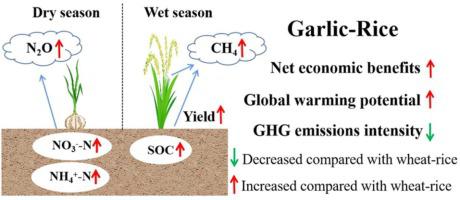Agriculture, Ecosystems & Environment ( IF 6.0 ) Pub Date : 2021-11-25 , DOI: 10.1016/j.agee.2021.107778 Tao Wang 1 , Hong Chen 1 , Wei Zhou 1 , Yong Chen 1 , Yong Fu 1 , Zhiping Yang 1 , Qi Liu 1 , Xueping Yue 1 , Fei Deng 1 , Malik Nkrumah 1 , Youfeng Tao 1 , Wanjun Ren 1

|
China is the main global garlic and rice producer and garlic–rice (GR) therefore represents an important crop planting system. However, the relationship between the agricultural output and greenhouse gas emissions under the GR system remains unknown. In this study, we analyzed the greenhouse gas emissions, crop yield, net economic benefits, and other potential influencing factors of the GR system, to explore the impact of different crop systems on food output and the environment. We used a wheat–rice (WR) system as the control and collected data for two years (2017–2018). Net economic benefits of the GR system were 28670.2 and 35799.8 CNY ha–1 in the two years, respectively, much higher than corresponding values of 2718.4 and 1825.6 CNY ha–1 for the WR system. Global warming potential was 78.43% and 168.66% higher for the GR system in the same years. Compared to the WR system, the global warming potential of the GR system was concentrated in the dry season, with the main contributor being N2O emissions (57.62%). Two-year greenhouse gas emission intensities calculated using net economic benefits (0.11 and 0.08) were less than one-fifth of those of the WR system. The GR system could therefore be an effective option for generating high net economic benefits with a low greenhouse gas emission intensity.









































 京公网安备 11010802027423号
京公网安备 11010802027423号